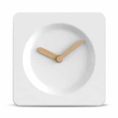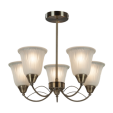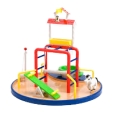Partial dentures replace natural teeth, allowing you to eat and speak with minimal (or no) discomfort. Removable partial dentures require nightly cleaning. They’re an ideal option for many dental patients, and there are several types of partial dentures you can choose.
Cast Metal Partial Dentures
Cast metal partial dentures are the most popular type of removable partial dentures. These are an excellent long-term solution — they’re lightweight yet sturdy. If you take good care of cast metal dentures, they may last years.
There are two basic types of cast metal dentures. The less expensive option attaches directly to your natural teeth via metal clasps. Precision attachments are more expensive but sometimes preferred for aesthetics. The clips are often plastic, but the function is the same.
Acrylic Flippers
Acrylic flippers are less common than cast metal dentures because they’re less comfortable to wear. However, they’re also less expensive. These dentures are thicker than cast metal dentures. The bulkiness prevents breakage.
The denture attaches to your natural teeth with metal clasps. While you can eat or talk with the denture attached, you may find it somewhat uncomfortable. Sometimes, others can see the clasps while you’re wearing the device. Some patients wear acrylic flippers for years with no issues, but they’re usually a short-term solution.
Flexible Dentures
Some patients are allergic to acrylic and find metal dentures uncomfortable. In this case, flexible dentures may be the best option. These partial dentures are more expensive than acrylic flippers, but they’re also more comfortable and less noticeable.
These dentures look more like natural teeth and gums, and the plastic is quite thin. Flexible partial dentures attach via thinner clasps that match your natural gums. Like acrylic flippers, flexible dentures are considered a short-term solution, though some patients wear them long-term successfully.
Fixed Bridge
Fixed bridges aren’t removable, but they’re a great choice if you have only one or two missing teeth. A traditional fixed bridge is placed between healthy teeth with a crown at either end. The primary downside is the way it adheres to your natural teeth, which may cause some damage or the possibility of tooth decay. It’s arguably the best option if you’re worried primarily about aesthetics, however.
Related: The Dental Crown Procedure: What to Expect
Implant-Supported Fixed Bridge
A fixed bridge isn’t an option for everyone. If you have more than one or two missing teeth or don’t want to risk damage to your existing teeth, an implant-supported fixed bridge may be the better option. This attaches to dental implants rather than natural teeth. It’s a permanent option that may last a lifetime, but the upfront cost may be prohibitive [1].
Which Partial Denture Is Best for Me?
There are several factors to consider when you’re choosing partial dentures. Your dentist can go over the pros and cons of each option. In general, they’ll consider:
- How many teeth you need to replace and how many natural teeth remain
- The anatomy and structure of your mouth and palate
- Whether you value cost over aesthetics or vice versa
- Any allergies or sensitivities you have
How to Take Care of Dentures
You should also consider proper denture care, which can vary depending on the type of denture you choose.
Partial Denture Adjustments and Repairs
You may expect some initial adjustments for your partial dentures. If the fit isn’t comfortable, never attempt to adjust the dentures yourself. You may break the dentures, and some dentures aren’t repairable. Sometimes, dentists can repair your dentures in-office quickly. More difficult repairs require more time, however.
Partial Denture Replacement
Over time, you may need new dentures or your dentist may refit your existing dentures with a new base. The time frame varies, but you can expect five to seven years of use for long-term partial dentures.
Oral Care With Partial Dentures
Regular oral hygiene is important. Brush your gums, tongue, and palate before you insert your dentures each day. Remove your partial dentures before brushing your natural teeth. Allow your gums to rest occasionally. Rinse your mouth with tepid salt water to clean your gums.
Dental Visits With Partial Dentures
Most dentists advise checkups every six months for partial denture patients.
Related: How Often Should You Go to the Dentist (And Why?)
Summary
If you’re considering partial dentures, it’s important to weigh the benefits of each type carefully. Nearly half of people over 65 wear dentures in Australia [2]. A dentist can help review your options and offer advice regarding which type of partial denture is best for you. Call now to book your next Denture Evaluation at Boon Dental!
1) Ali Hiddlestone. Dentures: How much will that new smile cost you? Retrieved from: https://www.canstar.com.au/health-insurance/dentures-cost/
2) Sergio Chrisopoulos and Jane Harford. Oral Health and Dental Care in Australia. Retrieved from: https://www.aihw.gov.au/getmedia/a62dd5db-a9eb-4ddb-b588-41ef726f1fcb/14804.pdf.aspx?inline=true











